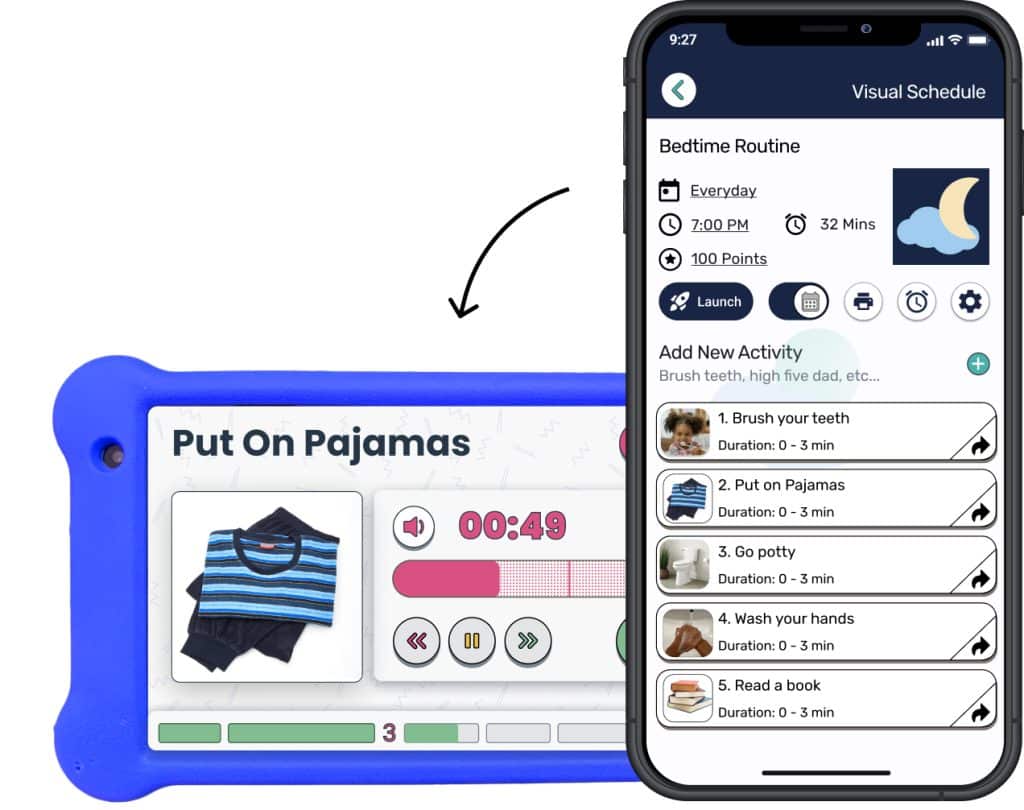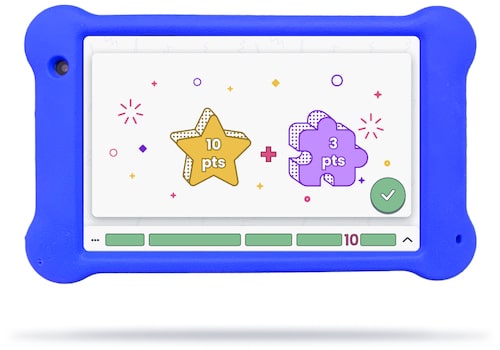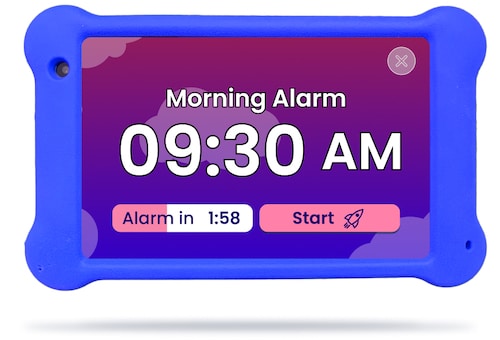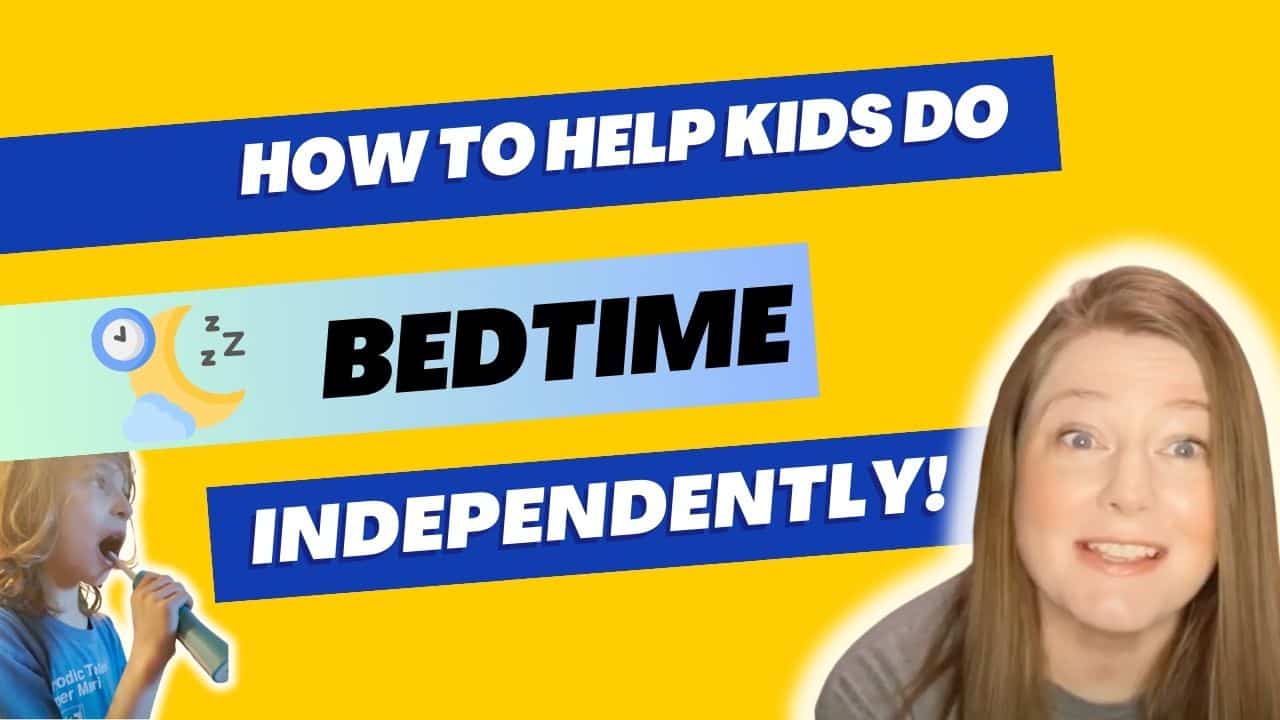If you find yourself wrestling your kids into their PJs as they plea for “just five more minutes” of TV, you’re in the right place. Below, we cover a step-by-step example of a bedtime routine that actually works, tips for doing bedtime independently, the 4 B’s of Bedtime, the 10-3-2-1-0 Sleep Rule, and even a free printable bedtime routine chart.
Table of Contents
What Is a Bedtime Routine?
We all know bedtime routines—in theory. But implementing them in a way that works for both parents and kids? That’s where the challenge lies. For instance, you’ve probably tried setting strict bedtimes or establishing rituals like reading a story together before lights out. However, without consistency or consideration of your child’s unique needs… well, the routine can quickly fall apart.
In short, the best bedtime routines happen roughly the same time each night. This signals to kids’ brains that it’s time to sleep—think teeth brushing, changing into PJs, or listening to soft music.
Example of a Bedtime Routine
| Bedtime Routine Steps | Duration |
|---|---|
| 1. Brush your teeth | 3 minutes |
| 2. Put on pajamas | 2 minutes |
| 3. Use the toilet | 5 minutes |
| 4. Wash your hands | 2 minutes |
| 5. Choose a calm-down activity | 5 minutes |
| 6. Earn Storytime! | 10 minutes |
Tips for Doing Bedtime Independently

Before you go printing the routine above… it’s almost 2024. There’s a better way to do this. Goally has the best tablet for kids to help kids learn life skills, like doing bedtime independently. It has a built-in yet completely customizable bedtime routine, night light, sound machine, and even morning alarm clock.
Every step of the bedtime routine gets a photo or a video, a time duration, and even an audio cue. Parent can upload their own visuals from the Parent App, which syncs to the tablet. At the end, Goally turns into a nightlight and sound machine to keep your child in bed.
| Goally Feature | How It Works | Example |
|---|---|---|
| Bedtime Routine | Kids follow step-by-step visuals to get ready for bed. | 
|
| Rewards | Kids earn points by completing their bedtime routine! | 
|
| Sleep Mode | Kids choose their own night light and sound machine. | 
|
| Morning Alarm | Goally wakes kids up without needing mom’s help. | 
|
"Goally has changed our lives. I no longer nag our son nonstop to complete basic tasks like getting ready for bed or cleaning his room!" — Goally Mom Learn more →
The Statistics and Insights

Certainly, the benefits of a consistent bedtime routine are backed by research. A study published in Sleep Medicine Reviews shows that children who follow regular evening routines have improved sleep quality and even sleep longer. And get this— kids with established routines also show better behavior and improved cognitive functioning during the day. It seems too simple, but it’s true: a consistent bedtime routine can have a major impact on your child’s health and well-being.
Read More: Autism & Sleep- What to Know and How to HelpHow to Build a Bedtime Routine: A Step-by-Step Guide
1. Set Consistent Sleep and Wake Times
- Determine the best times for your child to go to bed and wake up. Stick with these times as much as possible, even on weekends.
2. Create a Wind-Down Period:
- Start slowing things down about an hour before bed. This might include dimming the lights or reducing noise levels around the house.
3. Add Hygiene Habits:
- Include teeth brushing, face washing, and other necessary hygiene tasks into your routine.
4. Incorporate Relaxation Techniques:
- Add in relaxing activities such as reading a book together, gentle stretching exercises, or listening to soft music.
5. Create Visual Reminders (For Younger Kids):
- For younger kids with thinking and learning differences, create visual reminders of what each step of their bedtime routine should be. You could use pictures or simple drawings on a chart for this purpose.
The goal here is not perfection but progress. With patience and consistency, you’ll find what works best for your family’s unique needs—crafting an effective bedtime routine that benefits everyone involved.
Tip: Make one step of your bedtime routine a chosen activity that's different each night. Maintaining flexibility within your structure is vital. Life happens! You don't want to foster a rigid routine that causes stress when something unexpected comes up.
Read More: How to Put a Kid to Sleep in 40 Seconds
The Four B’s of Bedtime Routine
Let’s dive into the Four B’s—Bath, Brush, Book, and Bed. The idea here is to create a calm and predictable series of events your child associates with winding down for the night.
- Bath: It starts with a relaxing bath or shower.
- Brush: Next, brush your teeth.
- Book: Then comes story time, which is a great opportunity for bonding while promoting literacy skills in young children.
- Bed: Finally, it’s time to tuck them into bed with a goodnight kiss.
Read More: Calming Techniques For ADHD KidsThe 10-3-2-1-0 Sleep Rule
Meanwhile, if you’re struggling to establish consistency in your child’s sleep patterns, you might find value in the 10-3-2-1-0 Sleep Rule. In other words, this rule represents a countdown system towards bedtime: no caffeine 10 hours before bed; no food or alcohol 3 hours before bed; no work 2 hours before bed; no electronics 1 hour before bedtime; and zero being the number of times you hit snooze in the morning.
Overcoming Common Bedtime Challenges
Even with a solid routine, you may still encounter some bumps in the road. Here are some common challenges and tips on how to handle them:
- Resistance to bedtime: Try to make the routine enjoyable. If your child associates bedtime with fun activities, they may be more willing to cooperate.
- Difficulty falling asleep: Consider incorporating relaxation techniques, such as deep breathing or progressive muscle relaxation, into the routine.
Meanwhile, if your child wakes up during the night, try to keep interactions minimal and boring. This can discourage them from waking up for attention. After all, sleep is the ultimate goal here.
Bedtime Routine Tips: Age-Wise Comparison
| Babies (0-12 months) | Keep the environment quiet and dimly lit; stick to simple activities like lullabies, cuddles, or a warm bath. |
| Toddlers (1-3 years) | Incorporate story-time into the routine; begin teaching self-care habits like brushing teeth. |
| Kids (4-12 years) | Create visual reminders of the routine for younger kids with thinking and learning differences. Older kids may benefit from using apps that guide them through each step of their bedtime routine. |
Wrapping Up
In conclusion, there’s no perfect path to making the best bedtime routine. Rather, it’s going to take an understanding of what your child needs, coupled with trial and error. Start by setting consistent sleep/wake times, then build activities around this schedule, considering what relaxes them, whether it be storytelling or listening to soft music. Above all, patience plays an essential role throughout this process as every kid adjusts at their own pace.
FAQs About Bedtime Routines
What is a bedtime routine?
A bedtime routine is a series of steps that you and your child follow before bed. It can help your child wind down and relax, and it can also help them fall asleep more easily. A typical bedtime routine might include brushing teeth, putting on pajamas, and reading a story.
Why is a bedtime routine important for kids?
Because children who go to bed and wake up at the same time each day, which is a routine, tend to sleep better overall. It can also help children wind down, establish a sense of security, and signals to their bodies that it's time to sleep.
What are some examples of calming activities for a bedtime routine?
Reading a book, taking a warm bath, practicing relaxation exercises, or engaging in quiet play can help children relax before bed.
Should I include screen time in my child's bedtime routine?
It's best to avoid screen time close to bedtime as the blue light emitted from screens can interfere with sleep. Opt for calming activities instead.
What are some tips for creating a bedtime routine?
Here are some tips for creating a bedtime routine: Start by choosing a time that works for you and your child; Create a routine that is consistent and predictable; Keep the routine simple and age-appropriate; Make sure the routine includes relaxing activities; Avoid screen time in the hour before bed; and Create a calm and relaxing bedtime environment.
How long should a bedtime routine be for kids?
A bedtime routine can vary in length, but generally, aim for about 30 minutes to an hour to allow enough time for winding down and transitioning to sleep.This post was originally published on 10/10/2023. It was updated on 10/13/2023.

Goally
We help parents teach their kids life skills, like doing bedtime and morning independently. Backed by science, we incorporate evidence-based practices and expert-informed designs in all of our apps and content.







